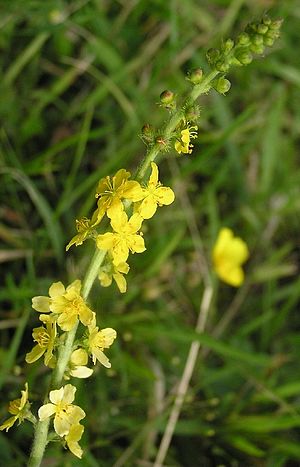Note: This is a project under development. The articles on this wiki are just being initiated and broadly incomplete. You can Help creating new pages.
Difference between revisions of "Agrimonia eupatoria - Agrimony"
Chaithrika (talk | contribs) (+adding internal link) |
m (Prabhakar moved page Agrimonia eupatoria to Agrimony (Agrimonia eupatoria)) |
(No difference)
| |
Revision as of 12:01, 28 March 2018
Agrimony is a species of agrimony that is often referred to as Agrimonia eupatoria, church steeples or sticklewort.
The whole plant is dark green with numerous soft hairs. The soft hairs aid in the plant's seed pods sticking to any animal or person coming in contact with the plant. The flower spikes have a spicy odor like apricots. In the Language of Flowers Agrimony means thankfulness or gratitude.
Description
The common agrimony grows as a deciduous, perennial herbaceous plant and reached heights of up to 100 cm (39 in). Its roots are deep rhizomes, from which spring the stems. It is characterized by its typical serrated edged pinnate leaves.[1]
The short-stemmed flowers appear from June to September, in long, spike-like, racemose inflorescences.
Uses
- Agrimony has been stated to have medical and magical properties since the time of Pliny the Elder. It is ruled astrologically by Cancer, according to Nicholas Culpeper. Common folklore held that it could cure musket wounds and ward off witchcraft.[clarification needed]
- Traditional British folklore states that if a sprig of the plant was placed under a person's head, they would sleep until it was removed.
- It cure coughs, skin eruptions and cystitis[2]
- It is mainly used as a gastro-intestinal tonic.[2]
In the ancient times, it was used for foot baths and tired feet. Agrimony has a long history of medicinal use. The English poet Michael Drayton once hailed it as an "all-heal" and through the ages it was considered a panacea. The ancient Greeks used agrimony to treat eye ailments, and it was made into brews for diarrhea and disorders of the gallbladder, liver, and kidneys. Anglo-Saxons made a solution from the leaves and seeds for healing wounds; this use continued through the Middle Ages and afterward, in a preparation called eau d'arquebusade, or "musket-shot water". It can has been added to tea as a spring tonic. In the traditional medicine (Austrian) the herb has been used internally as tea for disorders related to the liver and bile, gastrointestinal, and respiratory tract. Agrimonia has been listed as one of the 38 plants that are used to prepare Bach flower remedies. According to Cancer Research UK, essences are not used to treat medical conditions.
common name
- English - Common agrimony
